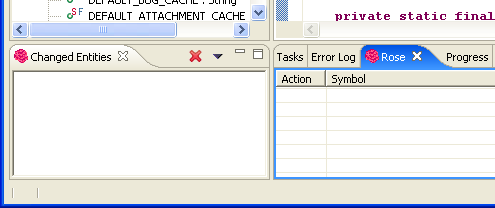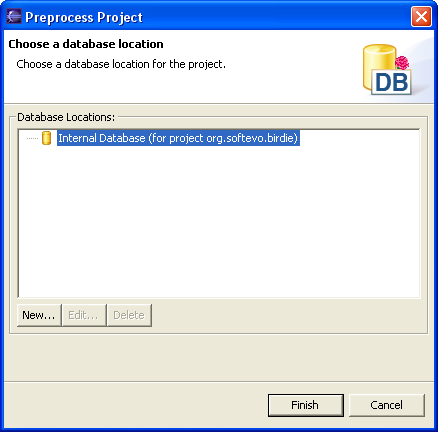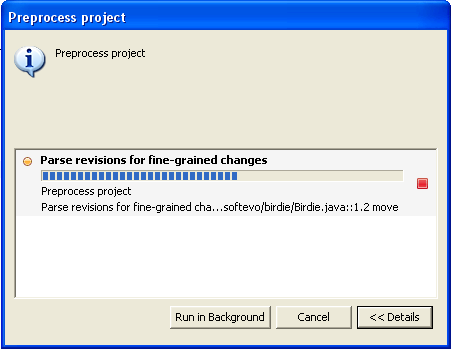
eROSE
Reengineering of Software Evolution in Eclipse
Universität des Saarlandes – Informatik
Informatik Campus des Saarlandes
Campus E9 1 (CISPA)
66123 Saarbrücken
E-mail: zeller @ cs.uni-saarland.de
Telefon: +49 681 302-70970



eRose is a plugin for Eclipse that guides programmers along related changes. If you change f() and other people have changed f() together with g() in the past, eRose will detect this and suggest "Programmers who changed function f() also changed function g()." All eRose needs is a CVS repository; we designed eRose to be as efficient and unobstrusive as possible.
Install eROSE
Smart way:- Start ECLIPSE.
- Select Help→ Software Updates→ Find and Install...
- Choose Search for new features to install and select Finish.
- Select New Remote Site... and enter:
- Name: Saarland University
- URL: http://www.st.cs.uni-saarland.de/softevo/erose/update-site/
- Include the update site "Saarland University" in your search and select Next.
- Choose the feature "eROSE: Reengineering of Software Evolution" and select Next.
- Read the license and accept the terms (if you agree) and select Next.
- Choose your ECLIPSE installation and select Finish.
- The feature is not signed (yet), so likely you will get a warning. Select Install.
- Restart your ECLIPSE workbench to complete the installation.
- You should now have two views Changed Entities and Rose (see below) in your Resource or Java perspective. If not, add both views with Window→ Show Views→ Other...→ Rose Views
- Download eROSE and unpack the zip-file into your ECLIPSE directory.
- Start ECLIPSE. You should now have two views Changed Entities and Rose in your Resource or Java perspective. If not, add both views with Window→ Show Views→ Other...→ Rose Views.

Setup eROSE for a project
- eROSE needs a database to perform fast mining. This database is created in this step.
Note that the creation of the database takes a while and cannot be interrupted. We recommend that you use eROSE only for small projects until we have implemented an incremental preprocessing. - Select eROSE→ Preprocess project... from the context menu of a project (that is shared with CVS). This opens the preprocessing wizard:

- Choose the "Internal Database" and click on "Finish".
- Now eROSE analyzes the CVS repository of this project. Click on "Details" for more information about the progress or select "Run in Background".

The preprocessing consists of four steps:
- Mirror CVS repository into database.
- Group revisions to transactions.
- Parse revisions for fine-grained changes (takes most of the time; see screenshot).
- Setup Rose tables.
- After the preprocessing has been completed you will be informed with a message box.

In case you have selected "Run in Background", check the progress of eROSE in the Progress view. The "OK" means successful completion.

Using eROSE
- Check that eROSE is enabled. The context menu of a resource should look like this (note that "Turn Rose on" is disabled):

- eROSE mines whenever you change something. You can find its recommendations in the Rose view:

eROSE gives three kinds of recommendations (see the Action column):
- CHG: Change the Symbol, e.g., the method usage().
- ADD_IN: Add something in the Symbol, e.g., the file BirdieProcessor.java. For JAVA "add" refers to fields, methods, or import statements.
- DEL_IN: Delete something in the Symbol, e.g., the file URLUtils.java. For JAVA "delete" refers to fields, methods, or import statements.
- To reset the recommendations of eROSE, use the "Clear" button in the Changed Entities view.

See also
- Project Software Evolution
- eROSE: Reengineering of Software Evolution in Eclipse
- APFEL: A Preprocessing Framework for Eclipse
Impressum ● Datenschutzerklärung
<webmaster@st.cs.uni-saarland.de> · http://www.st.cs.uni-saarland.de//softevo/erose/getting-started.php?lang=fr · Stand: 2018-04-05 13:41